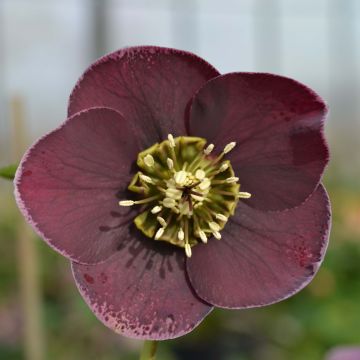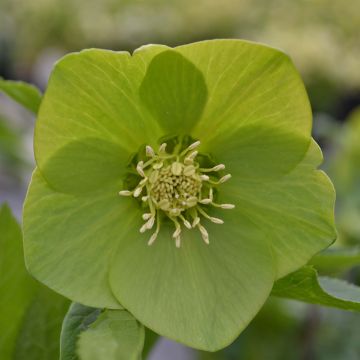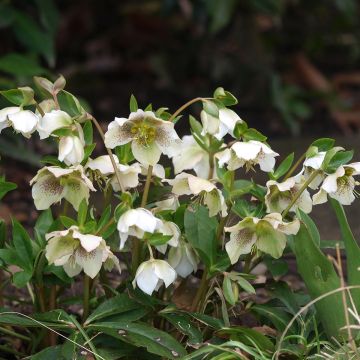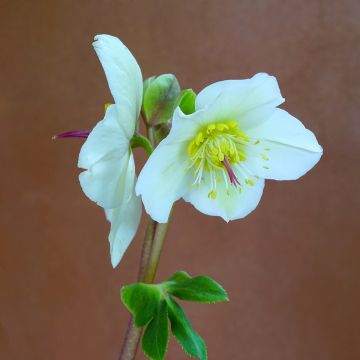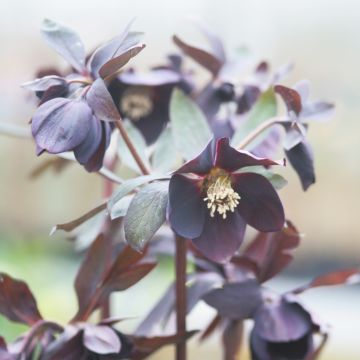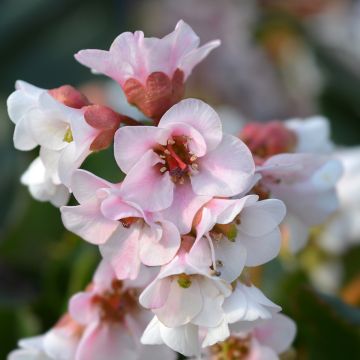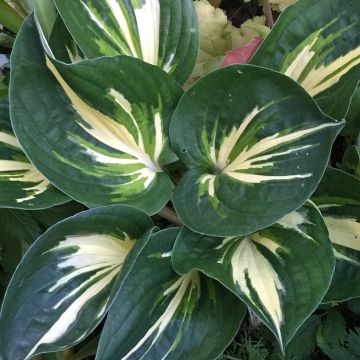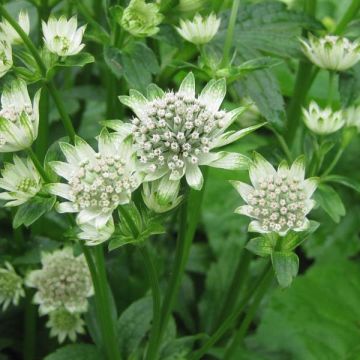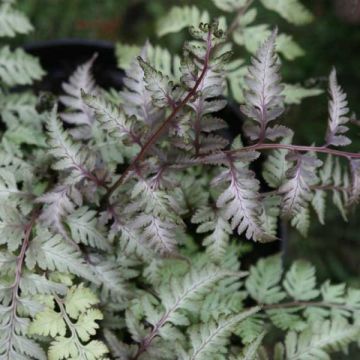

Helleborus hybridus (orientalis) ViV Olivia


Helleborus hybridus (orientalis) ViV Olivia
Helleborus hybridus (orientalis) ViV Olivia
Helleborus x hybridus (orientalis) ViV® Olivia
Lenten rose, Christmas rose
This item cannot be shipped to the selected country
Delivery charge from €5.90
More information
Schedule delivery date,
and select date in basket
This plant carries a 12 months recovery warranty
More information
We guarantee the quality of our plants for a full growing cycle, and will replace at our expense any plant that fails to recover under normal climatic and planting conditions.
From €5.90 for pickup delivery and €6.90 for home delivery
Express home delivery from €8.90.
Does this plant fit my garden?
Set up your Plantfit profile →
Description
The Oriental Hellebore Olivia is a very floriferous compact variety. Flowering from November, this Lenten Rose produces abundant single flowers in a bright cream-white colour, enhanced by the dark green evergreen foliage. It is a robust and hardy perennial that is easy to grow in all regions, even in heavy soil, although it prefers humus-bearing soils. It will create superb borders in shaded areas, and its limited growth also allows it to be easily grown in pots. Plant it under the shade of deciduous trees, where it will flower at the base in autumn.
The Hellebore (or ellebore) ViV 'Olivia' is a member of the Ranunculaceae family, which includes about sixty genera and around 2500 species. Many of them are poisonous beauties, meaning they contain toxic substances if ingested (natural protection to prevent them from being grazed by herbivores). Despite this, they are appreciated plants in the garden for their often highly ornamental flowering, as seen in Anemones, Buttercups, Trollius, Aconites, and many others, not to mention Clematis. The cultivar Olivia is a Belgian hybrid derived from the cross-breeding of Helleborus x ericsmithii. The parents are Helleborus niger, the true Christmas Rose, which comes from the Alps, and Helleborus x sternii, itself a hybrid obtained by crossing H. argutifolius, native to Corsica and Sardinia, and H. lividus, from the Balearic Islands. Olivia is a compact perennial, forming a clump 40 cm in height and width, which will thrive in the light shade of deciduous trees or even in denser shade, such as that generated by conifers. Its foliage consists of palmate basal leaves, slightly dentate, leathery, dark green, and glossy. These are evergreen leaves in winter, which only live for eight months and are regularly replaced by new leaves.
This very floriferous Hellebore begins flowering as early as November. Pink buds are abundantly produced and open up to reveal very light cream-white corollas. They consist of five rounded sepals that imitate petals, while the actual petals resemble small cones folded in on themselves. Light green in colour, they form a central circle that surrounds a cluster of protruding light yellow stamens. The corolla is sometimes slightly tinged with pale green, and the low winter sun creates beautiful transparencies as it shines through. The flowers succeed each other and abundantly renew until January, enchanting the garden during this often somewhat gloomy season. If they are positioned vertically or inclined downwards, allowing water to slide off like an umbrella, it protects the heart from rotting. Hellebores do not like to be moved once established, and young shoots occasionally take time to flower. Therefore, be sure to choose their location carefully when planting.
This perennial adapts to neutral to moderately alkaline (limestone) soils or even slightly acidic soils, preferably rich and retaining some moisture, although an established plant can withstand dry conditions well. It will thrive under leafy trees, allowing winter sun to pass through while protecting it from the intense summer sun. It is a relatively easy plant to succeed with and can also be grown in pots on your terrace due to its compact habit. In this case, monitor the potting soil to water it in a timely manner and prevent it from drying out.
Hellebores are unmatched in brightening up the dark days of autumn and winter. To enhance this effect, plant evergreen shrubs with variegated foliage alongside them, bringing light to the heart of winter. Standing at only 50 cm tall, Euonymus fortunei Goldy is a dwarf spindle tree that will coexist with your Hellebore without smothering it. Its extremely golden foliage is remarkably bright under a grey sky. Its cousin, Euonymus japonicus White Spire, forms a narrow column up to 1.50 m in height, with green foliage strongly variegated with white, similarly bringing brightness to a winter border. In mild climates, also consider Hebe Orphan Annie, a shrubby Veronica that forms a compact dome only 60 cm tall. Its delicate foliage is green-bordered with cream-white and tends to turn golden yellow in cold weather. In addition, it has a superb flowering of small magenta-pink spikes that extend from May to September.
Report an error about the product description
Helleborus hybridus (orientalis) ViV Olivia in pictures


Flowering
Foliage
Plant habit
Safety measures
Botanical data
Helleborus
x hybridus (orientalis)
ViV® Olivia
Ranunculaceae
Lenten rose, Christmas rose
Cultivar or hybrid
ingestion
Cette plante est toxique si elle est ingérée volontairement ou involontairement.
Ne la plantez pas là où de jeunes enfants peuvent évoluer, et lavez-vous les mains après l'avoir manipulée.
Pensez à conserver l'étiquette de la plante, à la photographier ou à noter son nom, afin de faciliter le travail des professionnels de santé.
Davantage d'informations sur https://plantes-risque.info
Other Oriental Hellebore
Planting and care
The Oriental Hellebore 'Olivia' grows in any neutral to moderately chalky soil, or even slightly acidic, rich, light or clayey, in partial or light shade while sheltered from cold and dominant winds. South of the Loire, particular attention should be paid to avoiding direct sunlight during the hottest hours. This perennial can be planted from early autumn to spring. It thrives in deeply cultivated soil mixed with organic matter. To fertilise, use bone meal or another organic fertiliser. Water the plants well after planting and add a layer of mulch 2 to 5 cm thick. Regularly remove faded leaves to improve flowering. Ensure a planting distance of 30 to 40 cm between each plant to promote their development. Hellebores do not tolerate stagnant water, as it can cause them to rot.
The roots should not completely dry out in summer. Hellebores can be affected by a fungal disease transmitted by aphids, known as black spot disease. Remove any stained leaves when the flower buds appear. Remove faded flowers after the seed falls. They can also suffer from grey rot or die from collar rot. This often occurs due to poor growing conditions and excessive wetness. Plant this perennial on a balcony or terrace in a pot 4 to 5 times larger than its size, as it needs space to develop its root system. Very hardy, this Hellebore can withstand temperatures as low as -15°C or even lower, allowing it to adapt to almost all regions.
Planting period
Intended location
Care
This item has not been reviewed yet - be the first to leave a review about it.
Shade-loving perennials
Haven't found what you were looking for?
Hardiness is the lowest winter temperature a plant can endure without suffering serious damage or even dying. However, hardiness is affected by location (a sheltered area, such as a patio), protection (winter cover) and soil type (hardiness is improved by well-drained soil).

Photo Sharing Terms & Conditions
In order to encourage gardeners to interact and share their experiences, Promesse de fleurs offers various media enabling content to be uploaded onto its Site - in particular via the ‘Photo sharing’ module.
The User agrees to refrain from:
- Posting any content that is illegal, prejudicial, insulting, racist, inciteful to hatred, revisionist, contrary to public decency, that infringes on privacy or on the privacy rights of third parties, in particular the publicity rights of persons and goods, intellectual property rights, or the right to privacy.
- Submitting content on behalf of a third party;
- Impersonate the identity of a third party and/or publish any personal information about a third party;
In general, the User undertakes to refrain from any unethical behaviour.
All Content (in particular text, comments, files, images, photos, videos, creative works, etc.), which may be subject to property or intellectual property rights, image or other private rights, shall remain the property of the User, subject to the limited rights granted by the terms of the licence granted by Promesse de fleurs as stated below. Users are at liberty to publish or not to publish such Content on the Site, notably via the ‘Photo Sharing’ facility, and accept that this Content shall be made public and freely accessible, notably on the Internet.
Users further acknowledge, undertake to have ,and guarantee that they hold all necessary rights and permissions to publish such material on the Site, in particular with regard to the legislation in force pertaining to any privacy, property, intellectual property, image, or contractual rights, or rights of any other nature. By publishing such Content on the Site, Users acknowledge accepting full liability as publishers of the Content within the meaning of the law, and grant Promesse de fleurs, free of charge, an inclusive, worldwide licence for the said Content for the entire duration of its publication, including all reproduction, representation, up/downloading, displaying, performing, transmission, and storage rights.
Users also grant permission for their name to be linked to the Content and accept that this link may not always be made available.
By engaging in posting material, Users consent to their Content becoming automatically accessible on the Internet, in particular on other sites and/or blogs and/or web pages of the Promesse de fleurs site, including in particular social pages and the Promesse de fleurs catalogue.
Users may secure the removal of entrusted content free of charge by issuing a simple request via our contact form.
The flowering period indicated on our website applies to countries and regions located in USDA zone 8 (France, the United Kingdom, Ireland, the Netherlands, etc.)
It will vary according to where you live:
- In zones 9 to 10 (Italy, Spain, Greece, etc.), flowering will occur about 2 to 4 weeks earlier.
- In zones 6 to 7 (Germany, Poland, Slovenia, and lower mountainous regions), flowering will be delayed by 2 to 3 weeks.
- In zone 5 (Central Europe, Scandinavia), blooming will be delayed by 3 to 5 weeks.
In temperate climates, pruning of spring-flowering shrubs (forsythia, spireas, etc.) should be done just after flowering.
Pruning of summer-flowering shrubs (Indian Lilac, Perovskia, etc.) can be done in winter or spring.
In cold regions as well as with frost-sensitive plants, avoid pruning too early when severe frosts may still occur.
The planting period indicated on our website applies to countries and regions located in USDA zone 8 (France, United Kingdom, Ireland, Netherlands).
It will vary according to where you live:
- In Mediterranean zones (Marseille, Madrid, Milan, etc.), autumn and winter are the best planting periods.
- In continental zones (Strasbourg, Munich, Vienna, etc.), delay planting by 2 to 3 weeks in spring and bring it forward by 2 to 4 weeks in autumn.
- In mountainous regions (the Alps, Pyrenees, Carpathians, etc.), it is best to plant in late spring (May-June) or late summer (August-September).
The harvesting period indicated on our website applies to countries and regions in USDA zone 8 (France, England, Ireland, the Netherlands).
In colder areas (Scandinavia, Poland, Austria...) fruit and vegetable harvests are likely to be delayed by 3-4 weeks.
In warmer areas (Italy, Spain, Greece, etc.), harvesting will probably take place earlier, depending on weather conditions.
The sowing periods indicated on our website apply to countries and regions within USDA Zone 8 (France, UK, Ireland, Netherlands).
In colder areas (Scandinavia, Poland, Austria...), delay any outdoor sowing by 3-4 weeks, or sow under glass.
In warmer climes (Italy, Spain, Greece, etc.), bring outdoor sowing forward by a few weeks.

































